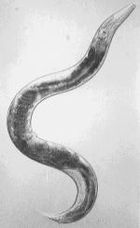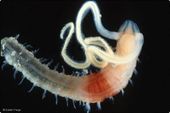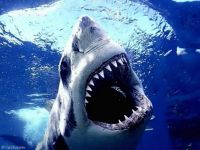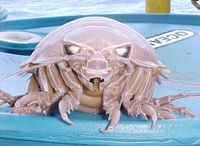Deep sea habitat
This article describes the habitat of the deep sea. It is one of the sub-categories within the section dealing with biodiversity of marine habitats and ecosystems. It gives an overview about the characteristics, the bottom topography, the adaptations to the environment of the biota and the threats.
Contents
Introduction
The deep sea floor represents the largest habitat on earth. It ranges from the edge of the continental shelf at about 200m depth to the bottom of the ocean. At the edge of the continental shelf is the shelf break, where the gradient of the floor increases down the continental slope. Below the continental slope lies a large sedimentary deposit, the so-called continental rise. At around 4,000 meters depth, the ocean floor is reached and extends over the ocean basins at depths of 5,000 metres on average. This is called the abyssal plain. The zone between the continental shelf and the abyssal plain is the bathyal zone. In some places, the sea floor drops again into elongated trenches with depths of 10 to 11 kilometres. This region is the hadal region. The ocean floor is interrupted by mountain chains known as the mid-oceanic ridge systems. Other features on the ocean floor are seamounts and hydrothermal vents. [1]
Characteristics
The temperature of the waters of the deep sea varies from 4°C to -1°C. Exceptions are the Mediterranean Sea with an average temperature of 13°C in the upper 4,000 metres and the Red Sea where the bottom water can reach temperatures up to 21.5°C at depths of 2,000 metres. The lowest temperatures of about -1.9°C are found in the Antarctic Ocean. The salinity of the seawater is relatively constant. Below 2,000 metres, the seawater salinity is close to 35 ‰ (34.8‰ ± 0.3 ‰) and at the very deepest layers it is 34.65‰. The oxygen concentrations are near saturation except in the oxygen minimum layer below the photic zone, between about 200 - 1500 m depth. This is related to oxygen consumption by microbial mineralization of organic matter sinking out of the photic zone (see Nutrient conversion in the marine environment and Possible consequences of eutrophication). The pressure in the deep ocean is very high; it increases by 1 bar ([math]10^5[/math] Pa, close to 1 atmosphere) per 10 meter increase in depth. [2] In the deep ocean, light is almost absent. It is a dark environment and the organisms are adapted to it. The circulation in the deep sea is dealt with in the article ocean circulation. The deep sea bottom has some specific characteristics discussed in the article Deep sea bottom.
Adaptations
Finding food and avoiding predation require special adaptations for the animals of the deeper layers of the water column where there is no plant growth at all. Many mid-water animals often have bizarre body shapes, because they never come into contact with a physical barrier. The most common form is more or less spherical, often with long and delicate extensions. Most animals do not need a rigid skeleton because they spend all their time suspended in water. An important adaptation is not to be seen too easily by potential predators. In the upper parts of the mesopelagic zone, where there is still some sunlight, many animals have more or less transparent bodies. An alternative is to have silver sides that act as mirrors and luminiscent organs along the bellies that hide the bodyshape. At deeper layers, the organisms have a dark red, black or brown colour. These colours do not reflect the most usual blue-green colour of bioluminescence. In these deeper waters, the anglerfish has a fishing rod with bioluminescent lures to attract preys. In the mid-water, many fishes have big teeth and big mouths to take up as much as possible. Dial vertical migration is another adaptation of many animals. The general pattern is that animals spend the daylight hours at depth and move upwards during the night. This is to avoid predation and to feed. Bioluminescence is another adaptation. Depending on the depth, organisms use it as camouflage to protect them from predators or to confuse or frighten predators rather than to hide from them. Other animals use it to look for a potential mate. A few deep-sea animals use it together with another light organ that produces deep red light. Other animals cannot see this red light, but the red light will be reflected very efficiently by the red bodies of the specific prey. The red light is a recognition mark for other members of the same species. An example of such an organism is the dragonfish Malacosteus. [3]
Biota
The mid-water communities include representatives of most major animal groups on Earth, from tiny single-celled organisms only a fraction of a millimetre, through all the invertebrate phyla, to fish several meters long. Most of them have an average size in the range of centimetres. The dominant species are crustaceans, fish and a variety of animals with soft and jelly-like bodies such as jellyfish.
The deep-sea floor is covered with many mounds and depressions formed by benthic animals such as worms, mollusks, crustaceans, starfish, brittlestars, shrimps, fishes sea cucumbers and sea urchins. Because the deep-sea floor is poor in food resources, it cannot support large populations of large animals. This causes large animals to be spread over a greater range than elsewhere. For this reason, many animals adopt a ‘sit and wait’ strategy. This strategy means that the animals stay at one place and wait until food is falling down or carried to them with the currents. These animals are sponges, sea anemones, tube worms, barnacles and other smaller animals.
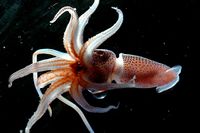 Squid with many light organs [4] |
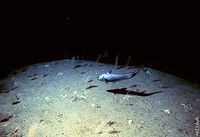 Deep-sea bottom with fish [4] |
 A gorgonian feeding on a basketstar [4] |
There are five groups that are dominant in terms of numbers. These are: foraminiferans, Radiolaria, nematodes, crustaceans (amphipod shrimps, isopods, copepods, bivalves) and polychaete worms.
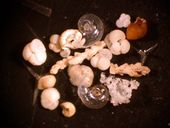 Foraminifera [4] |
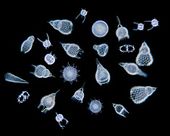 Radiolaria [5] |
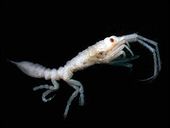 Isopod [6] |
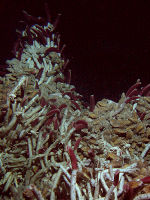
Hydrothermal communities - ecosystems associated with hydrothermal vents such as black smokers or white smokers - may be hundreds of times more abundant than on the adjacent sea floor. This is because the animals have their own rich source of food. This food source are the chemicals dissolved in the vent fluids, which are totally independent of the input from the photosynthesizing plants in the overlying surface waters. The basis of the food chain are chemosynthetic bacteria. They support many other organisms such as mussels, cockles, oysters, sea anemones, shrimps, crabs, fish and tube worms. An example of a tube worm is Riftia pachyptila. It has a red plume of gills sticking out of the top of the worm’s white tube. They are also found around cold hydrocarbon seeps. It has no mouth or gut and it has special chemosynthetic bacteria in the tissues of its body called the trophosome. The chemicals that the bacteria need are delivered by the blood of the worm. [3]
Cold seeps have a lower metazoan biodiversity but a higher productivity. This is because of the high biomass of megabenthic organisms. The communities are often dominated by bivalves that have symbiotic relationships with chemosynthetic bacteria. Organisms that can be found here are tube worms, bivalves, crabs, anemones and soft corals. An example of an organism is the vesicomyid clam that has a symbiotic relationship with sulfur oxidizing bacteria.
Seamounts have high concentrations of plankton. Fishes are also abundant, because of the high concentration of plankton and the constant influx of prey organisms. Marine mammals such as sharks, tuna and cephalopods all congregate over the seamounts to feed. Even seabirds have been shown to be more abundant in the zones with shallow seamounts.
Carcasses are hotspots for food. When a carcass reaches the bottom, it attracts amphipods within minutes. These crustaceans have powerful jaws, which can slice flesh. They can detect the odor of a carcass carried on the water currents. After them several fishes arrive and feed on the carcass. Shrimps can also occur on it. When these animals have eaten enough or when there is nothing suitable left for them, the remainders will attract slow-moving animals such as mollusks, starfish, brittlestars and sea cucumbers. Finally, bacteria will finish the job. They can even break down the bones. Within weeks the carcass is cleared away.
Giant animals and strange creatures are common in the deep sea. These are sometimes called monsters of the sea. There are a lot of examples. Many myths of monsters are based on sightings of squid. Sharks are also seen as monster and aggressive animals.
Other animals can be seen as monsters because they are very large in comparison to the species that we know. An example is the giant isopod. This phenomenon is called gigantism.
 Giant squid [4] |
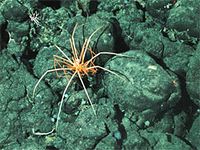 Sea spider [4] |
Threats
Human activities can cause serious damage to the deep sea. Examples of human activities that have a negative impact are [7]:
- Fishing activities: overfishing, bycatch or incidental mortality of non-target species, destructive practices and illegal, unreported and unregulated fishing activities (IUU) (see also Overexploitation).
- Noise pollution such as powerful sonar systems and airguns
- Shipping: noise, accidental spills of oil, discharge of garbage, oily wastes, sewage, chemical residues and ballast water, anti-fouling products
- Submarine cables and pipelines
- Pollution
- Climate change and ozone depletion
Related articles
References
- ↑ Kaiser M. et al. 2005. Marine ecology: Processes, systems and impacts. Oxford University Press. p.584
- ↑ Gage J.D. and Tyler P.A. 1991. Deep-sea biology – A natural history of organisms at the deep-sea floor. Cambridge University Press. p. 504
- ↑ 3.0 3.1 Rice T. 2000. Deep Ocean. The natural history museum, London. p. 96
- ↑ 4.0 4.1 4.2 4.3 4.4 4.5 4.6 Photo credit NOAA
- ↑ Photo credit Wim Van Egmont
- ↑ Photo credit Chris Perridas
- ↑ UNEP Regional Seas Report and Studies No.178. 2006. Ecosystems and Biodiversity in Deep Waters and High Seas. p. 60
Please note that others may also have edited the contents of this article.
|

